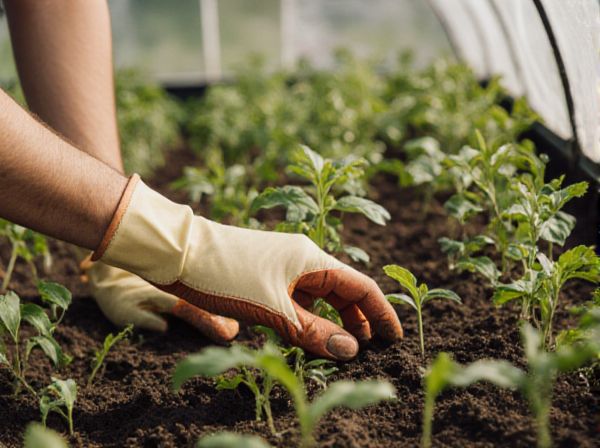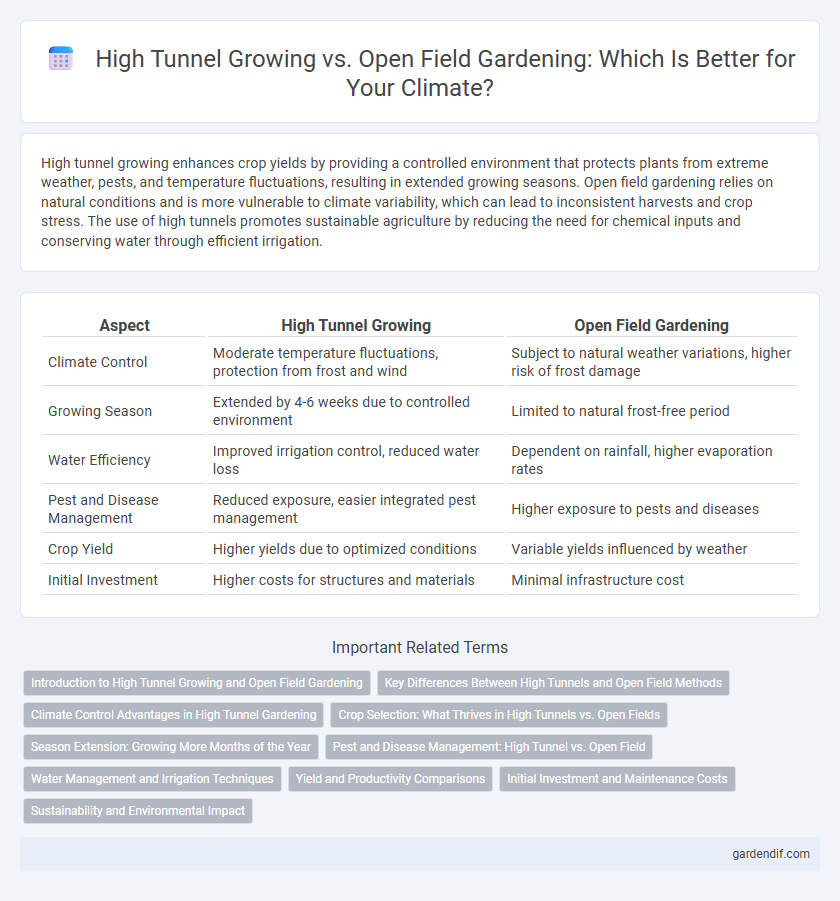
High tunnel growing vs open field gardening Illustration
High tunnel growing enhances crop yields by providing a controlled environment that protects plants from extreme weather, pests, and temperature fluctuations, resulting in extended growing seasons. Open field gardening relies on natural conditions and is more vulnerable to climate variability, which can lead to inconsistent harvests and crop stress. The use of high tunnels promotes sustainable agriculture by reducing the need for chemical inputs and conserving water through efficient irrigation.
Table of Comparison
| Aspect | High Tunnel Growing | Open Field Gardening |
|---|---|---|
| Climate Control | Moderate temperature fluctuations, protection from frost and wind | Subject to natural weather variations, higher risk of frost damage |
| Growing Season | Extended by 4-6 weeks due to controlled environment | Limited to natural frost-free period |
| Water Efficiency | Improved irrigation control, reduced water loss | Dependent on rainfall, higher evaporation rates |
| Pest and Disease Management | Reduced exposure, easier integrated pest management | Higher exposure to pests and diseases |
| Crop Yield | Higher yields due to optimized conditions | Variable yields influenced by weather |
| Initial Investment | Higher costs for structures and materials | Minimal infrastructure cost |
Introduction to High Tunnel Growing and Open Field Gardening
High tunnel growing utilizes polyethylene-covered structures to extend the growing season and protect crops from extreme weather, enhancing yield stability in variable climates. Open field gardening relies on natural environmental conditions, offering lower initial costs but increased vulnerability to temperature fluctuations and pests. Understanding these differences helps optimize climate adaptation strategies for sustainable horticulture.
Key Differences Between High Tunnels and Open Field Methods
High tunnels create a controlled environment that extends the growing season by protecting crops from extreme weather, pests, and temperature fluctuations, unlike open field gardening which relies solely on natural climate conditions. High tunnels improve soil moisture retention and temperature regulation, resulting in higher yields and faster plant growth compared to the variable conditions of open field methods. Open field gardening allows for larger crop diversity but is susceptible to climate-related challenges such as drought, frost, and heavy rains that can adversely impact plant health and productivity.
Climate Control Advantages in High Tunnel Gardening
High tunnel gardening offers significant climate control advantages by enabling regulation of temperature, humidity, and wind exposure, which extends the growing season and improves crop yield stability. These structures protect plants from extreme weather events such as frost, heavy rains, and strong winds, creating a more consistent and controlled environment compared to open field gardening. Enhanced microclimate conditions inside high tunnels also reduce pest and disease pressure, contributing to healthier plant growth and higher productivity.
Crop Selection: What Thrives in High Tunnels vs. Open Fields
High tunnels create a controlled environment that extends the growing season, favoring heat-loving crops like tomatoes, peppers, and cucumbers, which thrive in warmer, consistent temperatures. Open field gardening supports cold-hardy crops such as broccoli, cabbage, and root vegetables that require natural airflow and cooler conditions. Crop selection in high tunnels maximizes yield and quality through protection from extreme weather, while open field gardening leverages natural soil ecosystems and pollination.
Season Extension: Growing More Months of the Year
High tunnels enable season extension by providing a controlled environment that protects crops from frost, wind, and excessive rain, allowing gardeners to grow up to 3-4 months longer than traditional open field methods. By maintaining higher temperatures and reducing weather-related stress, high tunnels support earlier planting in spring and later harvesting in fall, maximizing yield potential. This extended growing season improves food security and offers economic benefits through prolonged market availability.
Pest and Disease Management: High Tunnel vs. Open Field
High tunnels provide a controlled environment that reduces exposure to pests and diseases compared to open field gardening, limiting pathogen entry and improving crop health. The enclosed structure helps maintain optimal humidity and temperature, which can suppress some fungal diseases, though it may also create conditions favorable for specific pests if not properly managed. Integrated pest management practices, including monitoring and biological controls, remain essential in both systems to effectively mitigate risks and protect crop yield.
Water Management and Irrigation Techniques
High tunnel growing offers superior water management by reducing evaporation and runoff compared to open field gardening, enabling precise irrigation control and enhanced moisture retention. Drip irrigation systems within high tunnels optimize water use efficiency, delivering water directly to plant roots, which minimizes waste and conserves resources. In contrast, open field gardening often relies on less efficient methods like overhead sprinklers, increasing water loss due to wind and evaporation.
Yield and Productivity Comparisons
High tunnel growing significantly increases yield and productivity by extending the growing season, providing a controlled environment that protects crops from extreme weather, pests, and diseases. Compared to open field gardening, high tunnels can boost crop yields by 20-50%, allowing for multiple harvests and intensifying production per unit area. These structures optimize temperature, humidity, and soil conditions, directly enhancing plant growth and overall agricultural output.
Initial Investment and Maintenance Costs
High tunnel growing requires a higher initial investment due to the cost of framing materials, plastic covers, and installation labor compared to open field gardening. Maintenance costs for high tunnels include periodic replacement of plastic films and structural repairs, while open field gardening mainly incurs expenses for soil preparation, pest control, and irrigation. Overall, high tunnels demand more upfront capital but can reduce seasonal risks, whereas open field gardening offers lower initial costs but potentially higher variability in yields and maintenance efforts.
Sustainability and Environmental Impact
High tunnel growing enhances sustainability by extending the growing season, reducing water usage through improved moisture retention, and minimizing the need for chemical pesticides compared to open field gardening. These structures also lower soil erosion and nutrient runoff, promoting healthier ecosystems and reducing greenhouse gas emissions. While open field gardening relies heavily on weather conditions and often requires more input resources, high tunnels provide controlled environments that support efficient resource management and climate resilience.
High tunnel growing vs open field gardening Infographic

 gardendif.com
gardendif.com